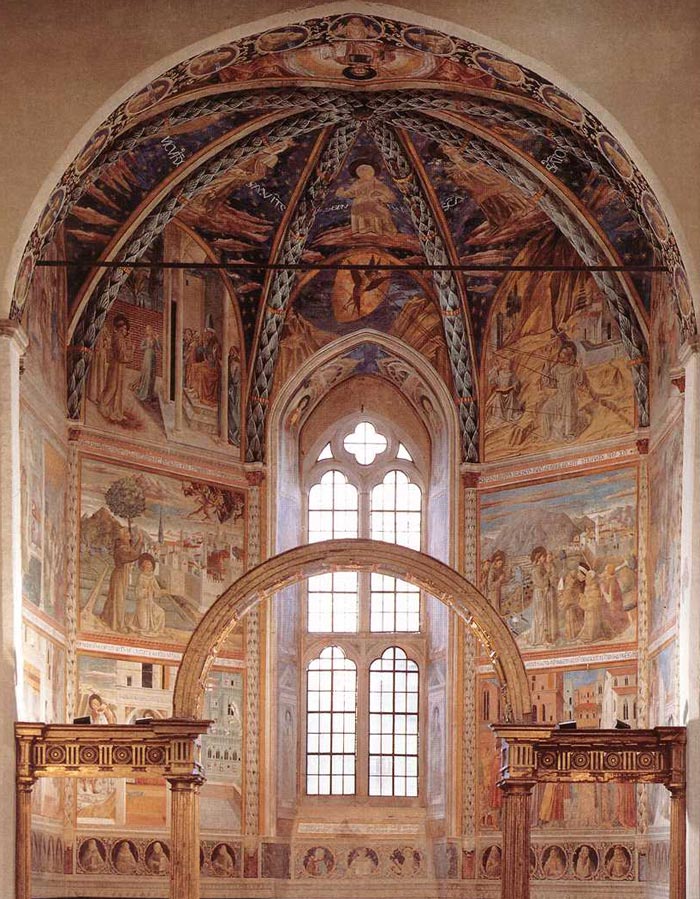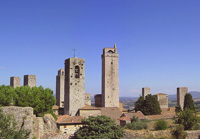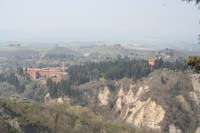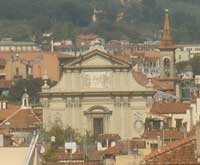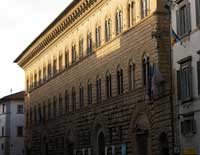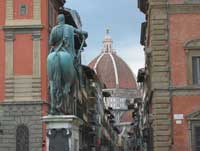| |
|
Scenes from the Life of St Francis
The Birth of Saint Francis, the Prophecy of the Pilgrim and the Homage of the Simple Man
|
 |
Scenes from the Life of St Francis (Scene 1, north wall), 1452, fresco, 304 x 220 cm, Apsidal chapel, San Francesco, Montefalco
|
The first scene illustrates three events from the life of Saint Francis: on the left, the Birth of Saint Francis, in the centre, the Prophecy of the Birth by a Pilgrim and, on the right, the Homage of the simple man. The birth episode is set in a simple dwelling. The newborn Francis is surrounded by onlookers and an ox and a donkey.
Outside the building, Benozzo illustrated two separate events, one before and one after the above-mentioned episode. The first takes place inside a building and is determined by the contrasting appearance of the kneeling, sitting and stooping women who are surrounding the child together with an ox and ass. To the right, along the street, the young Francis can be seen accompanied by a boy and, in the foreground, a kneeling beggar offers him his cloak.
On the left edge of the picture a woman in a red dress is supporting the saint's mother. The circular arrangement on the right conveys an intimacy from which the other two women almost seem to be excluded. The vertical and diagonal compositional lines, which are created by the arrangement of the figures and the architecture of the space, meet in the figure of the holy child, which thereby becomes the centre of the composition.
By means of disparities between the spatial and figural scale in the two following scenes, Benozzo creates differing levels of time. Francis' mother is standing at the top of a flight of steps. with her raised hands she is turning away the holy man who is identified as a pilgrim by his staff and bag. This meeting - chronologically the earliest event - is emphasized by the lines of the sloping roof and floor tiles, which converge compositionally at the mother's raised hands. It would be difficult to understand this scene if it were not for the explanatory inscription beneath: QUALITER B. F. FUIT DENU(N)TIATUS A XRO I(N) FORMA PEREGRINI QUOD DEBEBAT NASCI SICUT IPS(E) IN STAB(U)LO QUALIT(ER) QUIDA(M) FATUU(S) P(RO)STE(R)NEBAT B. F. VESTIME(N)TU(M) IN VIA - "How St. Francis was announced by Christ in the form of a pilgrim, and that he, like Christ himself, had to be born in a stable. And how a certain simple man spread his clothes out where St Francis was walking." It is Christ himself, therefore, who is heralding the birth of St Francis in the form of a pilgrim.
On the right an event from the saint's youth has been added. The young Francis is walking along the street accompanied by a boy. Though further in the background than the two figures on the steps, the two figures are depicted proportionally larger. In the foreground of the picture on the right, a poorly clad man is kneeling, looking up to the small window in the palazzo. He is laying his cloak at the feet of Francis. The direction in which the beggar is looking and the right hand that the saint has raised to fend him off indicate the real reason for the homage: it is not directed at the smartly dressed, youthful Francis, but the new-born child, who like Christ was born in sparse surroundings. In official descriptions of his life, the birth of Francis is not mentioned. Only the "Vita e Fioretti", a legend dating from the 14th century which was not included in the official canon of legends about St Francis, describes his birth in a stable. For that reason, this rarely depicted scene is also missing from the cycle of St Francis in Assisi.
The ox and ass, as well as the Prophecy of the Birth by the holy man, are motifs which create direct links with the birth of Christ and the annunciation to Mary. Even at the beginning of the cycle, analogies are already being created between Christ and Francis. With the deviation from the chronological sequence of events in the picture, Gozzoli is achieving a heightening of the tension within the picture. |
| |
|
|
The Dream of the Palace
|
|
|
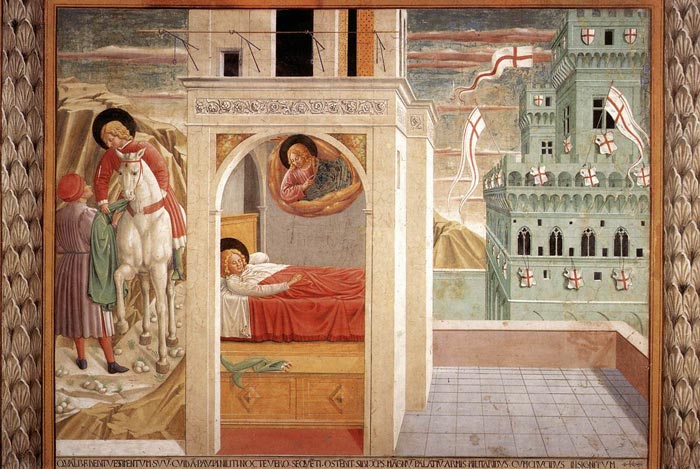 |
Scenes from the Life of St Francis (Scene 2, north wall), 1452, fresco, 304 x 220 cm, Apsidal chapel, San Francesco, Montefalco
|
The second fresco illustrates two episodes from the Saint’s youth. On the right, Francis is depicted in the act of giving his cloak to a noble but poor horseman. In the centre, the Dream of the Palace is depicted, in which Francis dreams of seeing a great and magnificent palace flying warlike banners bearing the sign of the cross and, when he asks to whom they belong, a heavenly voice answers that they will belong to him and his disciples.
The story once continued in the lost stained glass window (as we know from a surviving inscription) with Saint Damian’s Vision according to which the Saint, praying before the Crucifix, heard the voice of God no less than three times, repeating "Go, o Francis. Repair my house which is falling into ruin".
The second picture shows St Francis Giving away his Clothes, Vision of the Church Militant and Triumphant, two events from the saint's youth. What are conspicuous here are the weightings in the construction of the pictorial space. St Francis Giving away his Clothes seems to be pushed to the edge, clamped in between the frame on the left and the central building where the Vision is taking place. The well-dressed supplicant who is not, in contrast with tradition, depicted as a beggar is untypical. There can only have been one reason for taking this unusual approach to the theme: St Francis was not only merciful to the poorest members of society.
The narration of the Vision encompasses two spatially transposed areas of the painting. Due to the repeated use of the vine scroll pattern, the building in the foreground can be recognized as St Francis' parental home. Francis is lying within, asleep on a bed. As he dreams, Christ appears to him in a crown of clouds. He gazes down on the sleeping man and points to the right at a building decorated with numerous coats of arms and flags bearing the Cross. This is, as the inscription below the picture confirms, the castle which Christ shows the young St Francis in a vision: QUAL(ITER) B. F. DEDIT VESTIMENTUM SUU(M) CUIDA(M) PAU(PER)I MILITI NOCTE VERO SEQUE(N)TI OSTE(N)DIT SIBI XPS MAGNU(M) PALATIU(M) ARMIS MILITARIBUS CUM CRUCIBUS INSIGNITIUM "How St Francis gave his clothes to a poor soldier and Christ, during the following night, showed him a large castle decorated with coats of arms and crosses."
This scene is, in terms of form and colour, placed in relationship to St Francis Giving away his Clothes, for the rock formation that towers up behind the saint also appears in the background of the castle and presumably continues behind his parents' house. That makes the pictorial space appear considerably broader. In addition, the colours of St Francis' horse, his red garment and green cloak are related to the beflagged castle. The interpretation of this connection suggests itself: "Caritas" the saint's active brotherly love, is one of the three theological virtues and a "pillar" in the castle as a symbol of the heavenly Jerusalem. |
| |
|
|
The Renunciation of Worldly Goods
|
|
|
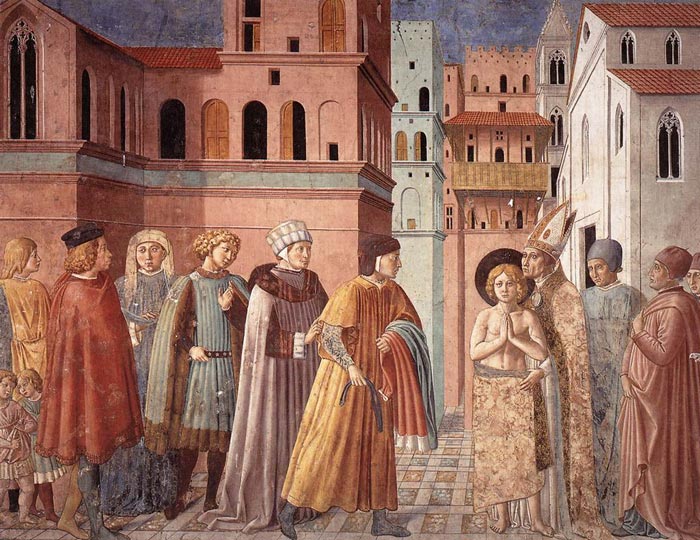 |
Scenes from the Life of St Francis ((Scene 3, south wall), 1452, fresco, 304 x 220 cm, Apsidal chapel, San Francesco, Montefalco
|
The episode depicted here is the Renunciation of Worldly Goods, in other words the moment when Francis decides to return his belongings to his father. The story is set amid complex architectural structures, with particular emphasis on the use of space and careful light effects. The focal point of this highly dramatic scene is Francis’ father, who intervenes, with an extraordinarily expressive face, while Francis takes off his clothes in a sign of his renunciation of all unnecessary property. The Bishop of Assisi, Guido II, covers the young man’s nudity with his own stole, richly decorated by Benozzo.
The Vision of San Damiano (on the lost stained-glass window) is followed by the Renunciation of Worldly Goods, the last of the scenes from the saint's youth. The scene takes place before the backdrop of a city.
The saint's father and his retinue take up two thirds of the foreground. On his left arm he carries his son's clothes, in the right he is holding his belt. A narrow space separates him from Francis, who is seen by the observer in a frontal view at prayer. A bishop is covering the saint with his pluvial, which indicates the religious nature of the scene, for it was worn by priests and bishops on ceremonial occasions other than Mass. The contrasting depiction of the father and son expresses the dramatic nature of their conflict, supported by the arrangement of two opposing groups of figures: the secular group is in movement, the religious one frozen. The explanatory inscription reads: QUALITER B. F. CORA(M) EPISCOPO ASISII REN(UNTIA)VIT PATRI HEREDITATEM PATERNAM ET O(M)NIA VESTIMENTA ET FEMORALIA PATRI REIECIT - "How St Francis renounces his father's inheritance before the bishop of Assisi and his father, and throws his upper garment and hose down before his father." |
The Meeting of Saint Francis and Saint Dominic
|
|
|
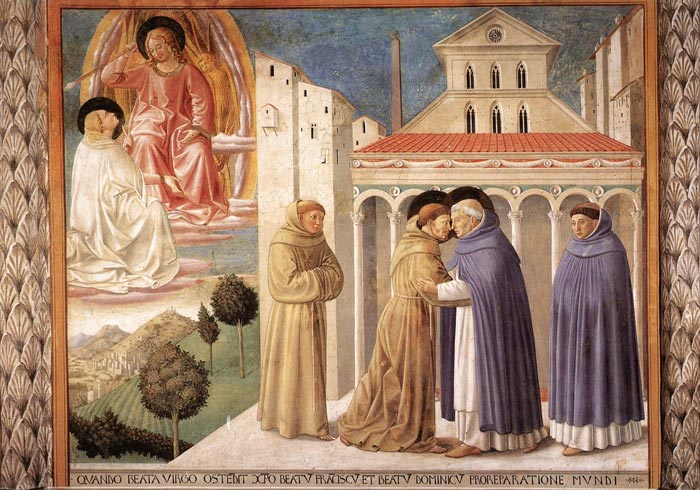 |
Scenes from the Life of St Francis (Scene 4, south wall), 1452, fresco, 304 x 220 cm, Apsidal chapel, San Francesco, Montefalco
|
The final scene in the lower register illustrates the Meeting of Saint Francis and Saint Dominic, an episode from the life of Saint Dominic recounted in the Golden Legend. Christ is about to hurl three spears (symbolising lust, greed and pride) at the sinful world, but Mary intercedes, pointing out the meeting between these two Saints who founded two important mendicant orders. This event, legend has it, took place in Rome in 1215 in front of the house of the Lord. The holy city is evocatively represented by Benozzo through an obelisk painted to the left of the church.
The last picture in the bottom row shows the Meeting of St Francis and St Dominic. Benozzo starts with the vision of St Dominic in the left half of the picture. Christ is about to hurl three spears - the symbols of pride, unchastity and greed - at the depraved world. Mary is attempting to prevent him by pointing to the meeting taking place between St Dominic and St Francis. The depiction of the saint is derived from the description written by Thomas of Celano in 1228: "Not particularly large in form; small rather than large, he had a not particularly large, round head, a somewhat long and stretched face, a level and low forehead, not particularly large black, pure eyes, dark hair, straight eyebrows, an even, fine and straight nose, upright, small ears, flat temples (...), close, regular and white teeth, narrow and soft lips, a black, not full beard, a slender neck, straight shoulders, short arms, gentle hands, long fingers."
For the first time in this cycle St Francis bears a tonsure and is dressed in the simple brown habit of a Franciscan, with a cord as a belt. This plain habit clearly distinguishes him from St Dominic, whose habit is a white tunic with a white scapular with a dark cape over it. In contrast with the rather more lavish Dominican attire, St Francis' simple habit refers to the ideal of poverty to which he dedicated himself for the rest of his life.
The two founders of orders met in Rome, as indicated by the obelisks which appear on the left side of the church. Benozzo places the scene, which according to legend took place in 1215, in front of a church, presumably Old St Peter's. This scene is not drawn from the legend of St Francis but from the life of St Dominic in the "Legenda Aurea" (Golden Legend).
The accompanying inscription reads: QUANDO BEATA VIRGO OSTE(N)DIT XPO BEATU(M) FRANCISCU(M) ET BEATU(M) DOMINICU(M) PRO REPARATIONE MUNDI - "How the blessed Virgin pointed St Francis and St Dominic out to Christ, for the renewal of the world." This picture concludes the bottom row of the pictures on the right southern wall. |
The Dream of Innocent III and the Confirmation of the Rule
|
|
|
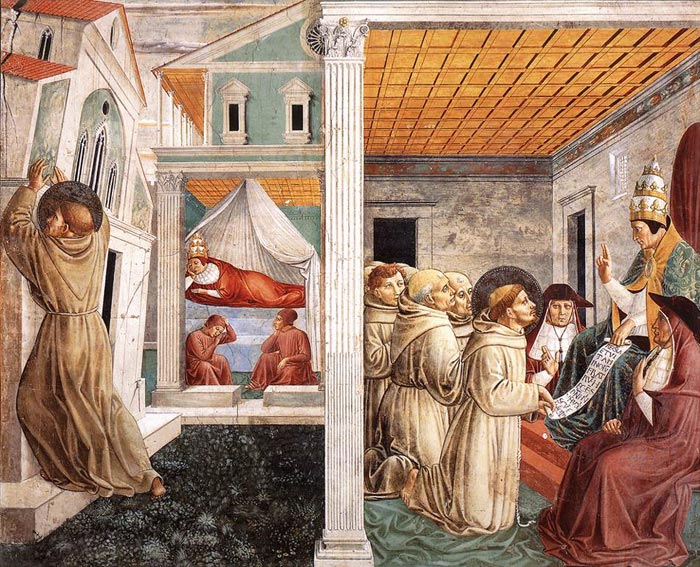 |
Scenes from the Life of St Francis (Scene 5, north wall), 1452, fresco, 304 x 220 cm, Apsidal chapel, San Francesco, Montefalco
|
The story then continues on the left-hand wall in the second register, immediately above the Birth of Saint Francis. Two episodes are illustrated in this panel: the Dream of Innocent III and the Confirmation of the Rule. The first episode depicts Pope Innocent III who had a vision of the Lateran Basilica collapsing and poor Francis toiling to hold it up. This "premonition" is a consequence of the story narrated on the right-hand side in a beautiful scene featuring Pope Honorius III (Pope Innocent’s successor) who approved the Rule of the Franciscan Friars in 1223 in his Bull, Solet annuere. This event is often mistakenly attributed to Innocent III, who did not officially approve the Rule but gave his consent to its "testing".
The sequence of pictures continues on the left north wall in the second row, meaning that the next picture is above the Birth of St Francis. It depicts the Dream of Innocent III and the Confirmation of the Rule by Pope Honorius III, the successor of Innocent III. The depiction of chronologically separate events and two popes in one picture is designed to do justice to the actual historical facts, which were frequently confused by painters who depicted the oral confirmation of the rule by Innocent III as having been a written approval.
A fluted pillar in the centre of the picture divides it into two halves. This method of structuring the surface of the picture has already been seen in the first fresco. The pope's vision shows a monk hurrying up on the left in order to support the Lateran basilica that is about to collapse. In front of the church a lavish meadow covered with numerous flowers and grasses is spread out. In the fine arts, the legends of St Dominic and St Francis were from time to time confused. Sometimes it is Dominic who has the crucial role of supporting the collapsing Lateran basilica. This depiction appears, for example, in two predella panels by Fra Angelico: in the altar showing the Sacra Conversazione, 1435/36, now in the Museo Diocesano in Cortona, and in the Coronation of Mary, now in the Louvre in Paris.
In addition, Benozzo's method of depiction here gives us an insight into the modernity of his visual language. When compared to the fresco by Giotto at Assisi, it is noticeable that the latter chose a stronger angle of inclination to express the gap between dream and reality. Benozzo made use of a different solution. He placed the dreaming pope in the rear and St Francis in the front picture plane, and in so doing was making use of a compositional principle that was popular during the Renaissance. The right half of the picture shows the confirmation of the rule taking place inside a palace. The pope has raised his right hand in blessing and in his left is holding an open scroll of parchment which St Francis has grasped at the lower edge. On the scroll the following words can be read: REGULA ET VITA MINORUM FRATRUM H(A)EC E(ST): D(OMI)NI NOSTRI IHESU XRI SANCTUM EVA(N)G(E)L(IUM) (OBSERVARE) - "It is the rule and the life of the Minorites to observe the Gospel of Jesus Christ our Lord."
|
Expulsion of the Devils from Arezzo
|
|
|
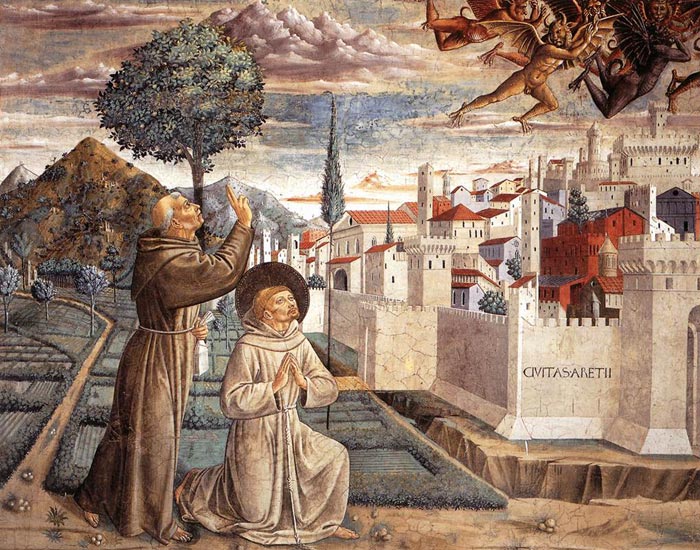 |
Scenes from the Life of St Francis (Scene 6, north wall), 1452, fresco, 304 x 220 cm, Apsidal chapel, San Francesco, Montefalco
|
This scene depicts the Expulsion of the Devils from Arezzo. The town of Arezzo is identifiable not only by the writing on its walls but also by the accurate view of the buildings which Benozzo painted as they stood in his day in order to visually aid viewers in recognising the location.
In the following scene of The Expulsion of the Devils from Arezzo, the saint drives the devils out of the city. An inscription on the city walls names the place where the event took place: CIVITAS ARETII. It is not, however, identifiable solely by the added sign with the place name, for Benozzo has created a realistic image of Arezzo in his depiction of the church of San Francesco, the baptistery of Santa Maria Assunta, the Palazzo Pretorio, the cathedral of San Donato and the municipal palace. Some of the buildings which stood there during the artist's life were not built until after the death of St Francis. With this picture of the town, familiar to observers of the time, Benozzo was reminding his contemporaries of the continuing validity of the saint's authority.
The small-scale landscape is arranged as if seen from above. The two figures in the picture - an older Franciscan monk whose hand is raised in blessing to heaven, and St Francis who is kneeling, deep in prayer - do not blend harmoniously with the landscape but appear to be standing in front of a backdrop. In addition, it becomes noticeable that the landscape and city views are not depicted using a uniform perspective. In this context it is significant that the two figures cover the transition in the picture from city to countryside.
This is another scene in which the artist deviated from the familiar scheme: instead of using an architectural backdrop, he placed the two protagonists in a lavishly painted landscape.
The inscription beneath the picture reads: QUANDO BS.F. EXPULIT DEMO(N)ES DE CIVITATE ARETII DIVINA POTENTIA ET PACIFICAVIT TOTU(M) POPULU(M) - "How St Francis used divine power to drive the devils out of the city of Arezzo and brought peace to the entire population." |
| |
|
|
Preaching to the Birds and the Blessing of Montefalco
|
|
|
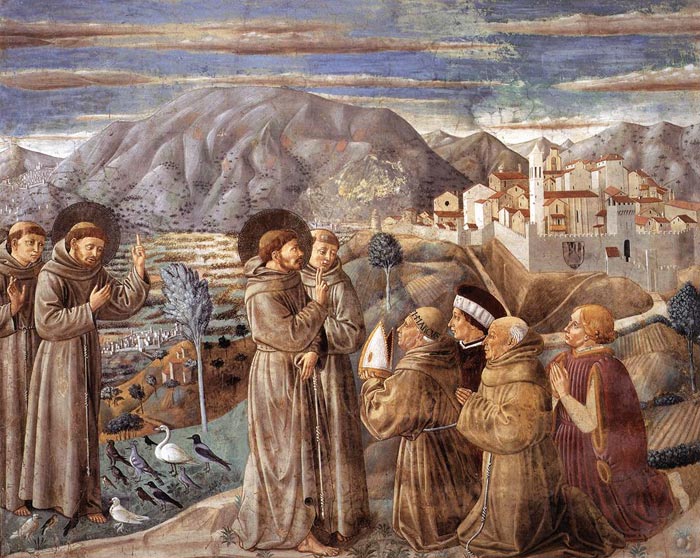 |
Scenes from the Life of St Francis (Scene 7, south wall), 1452, fresco, 304 x 220 cm, Apsidal chapel, San Francesco, Montefalco
|
The next episodes - Preaching to the Birds and the Blessing of Montefalco - are set in a real landscape depicted in minute detail. On the left, at the foot of the mountain, is Assisi with its castle and the imposing Convent Church of St. Francis, built only after the Saint’s death. Francis speaks to the birds (thirteen different species of which are portrayed here) while pointing to the sky to indicate that he is inspired in this act by God the Father. On the right-hand side of the panel, Montefalco, encircled by its town walls, forms the backdrop to the figures in the foreground.
Francis, accompanied by his disciple, blesses four praying men, one of whom is recognisable as the Franciscan friar Jacopo (who commissioned the work) and, presumably, two members of the Calvi family who made several significant donations to the Church of St. Francis in Montefalco in the fifteenth century. This blessing is a reference to a local tradition and is not mentioned in any stories from the life of Saint Francis.
The Preaching to the Birds and Blessing Montefalco took place in Umbria. The precise topographical description of the places is noticeable. In the middle distance a view of the Umbrian town of Bevagna can be seen, near to which the preaching to the birds is supposed to have taken place. The mighty Monte Subasio, with a little church half way up, and a view of the town of Assisi, form the background. In the background on the left, at the foot of the table mountain, lies Assisi with the fortress and magnificent monastery church of San Francesco that was not built until after St Francis' death. The topography of the cities is also in accordance with reality: Assisi lies to the north west of Montefalco.
The preaching Francis is pointing upwards to indicate that he is speaking about God. The 13 different kinds of birds, including a hoopoe, a swan, a thrush, a magpie, a pheasant and a dove, underline by their exceptional, unnatural gathering the godliness of the conversation.
Almost in the centre of the picture, the saint and his companion appear simultaneously a second time. The two scenes are compositionally separated by the two figures which are seen standing in profile. Not until they reach the background do the two landscapes meet. Various chronological levels become evident in the conscious division of the pictorial space. On the wall the city coat of arms of Montefalco appears.
Before St Francis, four men are reverently kneeling. The one in the front is wearing a Franciscan habit and a cap bearing the inscription M. MARCUS. He is holding a bishop's miter in his hands. This might be the "Master Marcus" who towards the end of the 14th century was the bishop of Sarsina and later of Marsico Nuovo. Fra Jacopo, who commissioned the work, is the second kneeling Franciscan. The other people are presumably members of the Calvi family, which in the 15th century acted on several occasions as donors for the church of San Francesco in Montefalco.
The inscription beneath the picture describes what is taking place: QUANDO B. F. PR(A)EDICAVIT AUIBUS APUD MEUANEUM DEMU(M) BENEDIXIT MO(N)TEM FALONE(M) ET P(O)PULU(M) - "How St. Francis preached to the birds and then blessed Montefalco and the population."
This scene shows Sant’ Agostino before the campanile was lowered in 1489.
|
| |
|
|
Saint Francis with the Knight of Celano
|
|
|
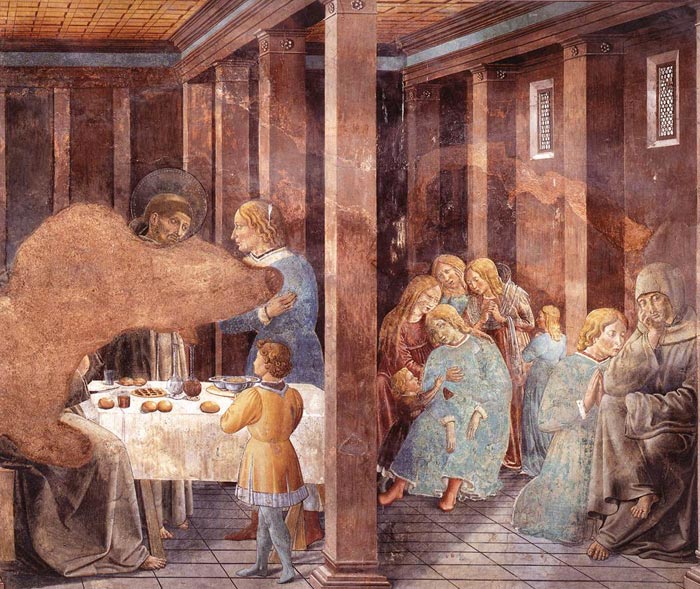 |
Scenes from the Life of St Francis (Scene 8, south wall), 1452, fresco, 304 x 220 cm, Apsidal chapel, San Francesco, Montefalco
|
This fresco shows the interior of a typical Renaissance house, with a coffered ceiling and a tile-covered floor. A hallway, marked out by pillars, divides the room into two parts. The left-hand side, where there are many gaps in the fresco, narrates the lunch of Francis with the Knight of Celano. Legend has it that, during this meeting, the Saint predicted the nobleman’s death. The story continues on the right-hand side, in chronological order, with the Knight, after Francis’ announcement, resolving to atone for his sins. This is followed, in the background, by his sudden death.
The cycle continues in the third register in which the scenes are framed by the five lunettes (one above each wall including the central wall occupied by the great window). In this upper section, Benozzo depicts one event at a time, with one significant exception, namely the episode of the Stigmatisation of Saint Francis, which occupies two lunettes. The artist undoubtedly wished to underline, in this way, the importance of Francis, the only saint to receive the stigmata, the marks of Jesus.
The second row concludes with the Death of the Knight of Celano. It depicts the extensive interior of a private residence which is furnished with a wooden coffered ceiling and a tiled floor. In the centre of the picture a pillared walkway divides the room into two areas. The left half of the picture is missing considerable sections of paint. The depiction of a person sitting at a table has been almost totally destroyed. Nonetheless, the remaining fragments make it possible to identify him. He must be a Franciscan monk, for the lower part of his monastic attire is still visible.
The picture combines three scenes: in the left half of a pillared hall with two aisles and a coffered ceiling, St. Francis is prophesying the Knight of Celano's imminent death and begging him to make his confession. The events continue chronologically on the right of the picture. The nobleman's confession to the Franciscan monk is followed in the background by his sudden death.
The inscription reads: QUANDO BS. F. FUIT INVITATUS AD PRANDIUM A COMITE DE CELANO ET TU(N)C B. F. PR(A)EDIXIT SUAM MORTEM - "How St Francis was invited to a meal by the knight of Celano, whose death was prophesied by St Francis." |
| |
|
|
The concluding four pictures start in the third row of the right north wall. The picture fields become narrower towards the top, as they are the lunettes of the individual walls. For this reason, and because of the greater distance from the viewer, Benozzo only depicts one event in each picture in the upper row. There is, however, one exception: the stigmatisation takes place in two picture fields. In this way, Benozzo honours St Francis of Assisi as the most important of the saints bearing the stigmata.
|
The Nativity Scene in Greccio
|
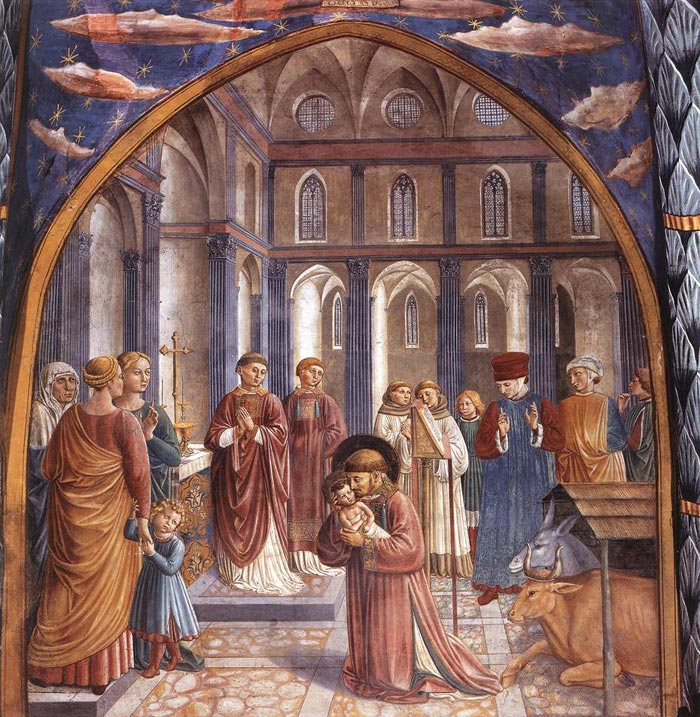 |
Scenes from the Life of St Francis (Scene 9, north wall), 1452, fresco, 304 x 220 cm, Apsidal chapel, San Francesco, Montefalco
|
At Christmas in 1223, Saint Francis, wishing to recreate the mystical atmosphere of the Nativity in Bethlehem, put on a living nativity scene in Greccio with the help of the local population. Everything was prepared and, that night, with authorisation from Pope Honorius III, the world’s fist living nativity scene was enacted.
Benozzo sets this episode inside a rather unusual church with architectural styles typical from two different eras. Indeed, on one side, the perforated windows and pointed arches are reminiscent of ancient Gothic churches while, on the other, the fluted pilasters, marble trabeations and circular windows are traditional Renaissance elements originating from Classical forms.
The picture shows the birth of Christ being celebrated in the monastery of Greccio. St Francis, who is kneeling in the foreground inside a church, is lovingly cradling the crib figure of the Christ Child in his arms, thus bringing it to life. The faithful who have gathered to celebrate mass notice the miracle and are gazing in reverence and astonishment at the scene.
The Establishment of the Manger at Greccio, probably the most impressive picture in the cycle, takes place in a church interior that is constructed according to the laws of central perspective. The vanishing point lies behind the third pilaster in the rear wall. The perspective, therefore, is not used in the sense of a "symbolic form", according to which the central motif of the picture - the spiritual closeness of the saint and the Christ Child - would have to appear at the vanishing point. The motionless figures of the faithful and St Francis and the animals resting in the stable in Bethlehem support the static composition of the picture and give the event an air of sacred solemnity. The architecture of the church interior is composed of two different stylistic epochs: the tracery windows and pointed arches are Gothic architectural forms, while the fluted pilasters, straight cornices and oculus windows are architectural elements typical of the Early Renaissance.
The legend of St Francis written by St Bonaventure tells us about the Christmas celebrations in Greccio. It has been shown that Greccio, which lies a little beyond the southern border of Umbria, near Rieti in northern Latium, was the first place where a manger was set up.
The inscription added beneath the picture reads: QUANDO BS. F. FECIT REPRESENTATIONEM NATIVITATIS ET AP(P)ARVIT SIBI CHRISTUS IN BRACHIIS - "How St. Francis arranged for a representation of Christmas and the Christ Child appeared in his arms." |
| |
|
|
The Conversion of Sultan Melek-el-Kamel
|
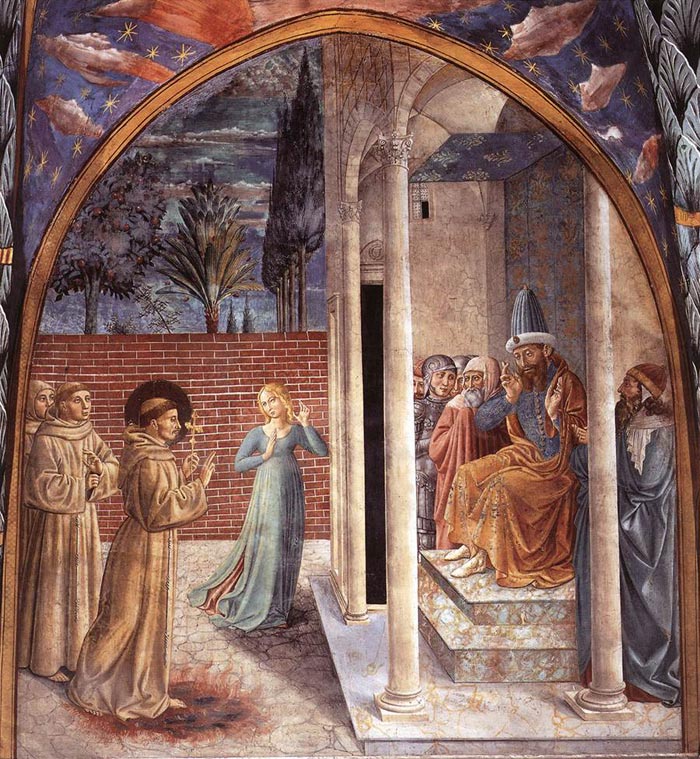 |
Scenes from the Life of St Francis (Scene 10, north wall), 1452, fresco, 304 x 220 cm, Apsidal chapel, San Francesco, Montefalco
|
n this lunette, Benozzo narrates one of the miracles performed by Saint Francis during his life. While in Egypt, at the court of Sultan Melek-el-Kamel, he succeeded not only in converting the Eastern prince but also in evangelising a woman who had approached him with the intention of seducing him. With joy and simplicity, Saint Francis threw himself into the fire, inviting her to join him, in a demonstration of the protective power of God.
Benozzo connects the Trial by Fire before the Sultan with another event. The dancing girl from the "Fioretti," who is shown here between the two main figures in the scene, has been ordered by the Sultan to attempt to seduce the saint, and she later converts. She is used to loosen up the otherwise rather stiff composition, but at the same time also creates a link as regards content between the two groups.
From the throne room of the richly-decorated palace Sultan Melek-el-Kamel and his servants follow the amazing events by which Francis proves God's protective powers. Only the date palm behind the red brick wall gives an indication of the oriental setting. The architectural elements of the palace and the row of cypresses, however, originate in the architecture of contemporary Italian nobility.
The accompanying inscription reads: Q(UA)NDO SOLDANUS MISITUNA(M) PUELLA(M) AD TE(N)TA(N)DUM B. F. ET IP(S)E I(N)TRAVIT I(N)IGNE(M) ET OMNES EXTUPUERUNT - "How the sultan sent a girl to tempt St Francis, and how he walked through fire and amazed everyone." |
| |
|
|
Stigmatisation of the Saint
|
 |
Scenes from the Life of St Francis (Scene 11, south wall), 1452, fresco, 304 x 220 cm, Apsidal chapel, San Francesco, Montefalco
|
The scene Stigmatisation of the Saint frescoed on the part of the lunette above the window is connected to the fresco painted on the right-hand wall. Rays emanate from the Crucifix, upheld by seraphim, and strike Saint Francis, kneeling with his hands raised. These are the five wounds of Christ that Saint Francis received on 14th September (the Feast of the Cross) 1224 in La Verna, Tuscany, a miracle that had never occurred before and which sealed the union between Saint Francis and Jesus Christ.
The Death and Assumption to Heaven of Saint Francis, Church of St. Francis, Montefalco.
Benozzo connected the small lunette above the window to the Stigmatisation of St Francis on the right south wall. The lunette shows the winged Cross floating over a rock formation. Rays emanate from the Cross surrounded by seraphs; they converge on the bordering picture field and the kneeling saint whose hands are raised. It is the five wounds of Christ that St Francis is receiving. Due to the chosen sequence of the scenes, the stigmatisation is given particular prominence. The rays do not hit the saint directly, as they change their direction while en route.
Receiving the stigmata was the most important event in the life of the saint and happened in 1224 on the mountain of La Verna in Tuscany. Gozzoli has depicted this scene across two wall fields: the direction in which Francis and the sitting monk are looking, as well as the cluster of rays, lead us across to a second picture field above the central lunette of the choir, which is bordered by the window jamb. Here the Crucifix and seraphs appear, surrounded by a shining mandorla.
The inscription reads: QUANDO BEATUS FRA(N)CISCUS IN MO(NTE) ALVERNE RECEPIT STIGMATA YHV XRI - "How St Francis received the wounds of Jesus Christ on the mountain of La Verna." |
| |
|
|
The Death and Assumption to Heaven of Saint Francis
|
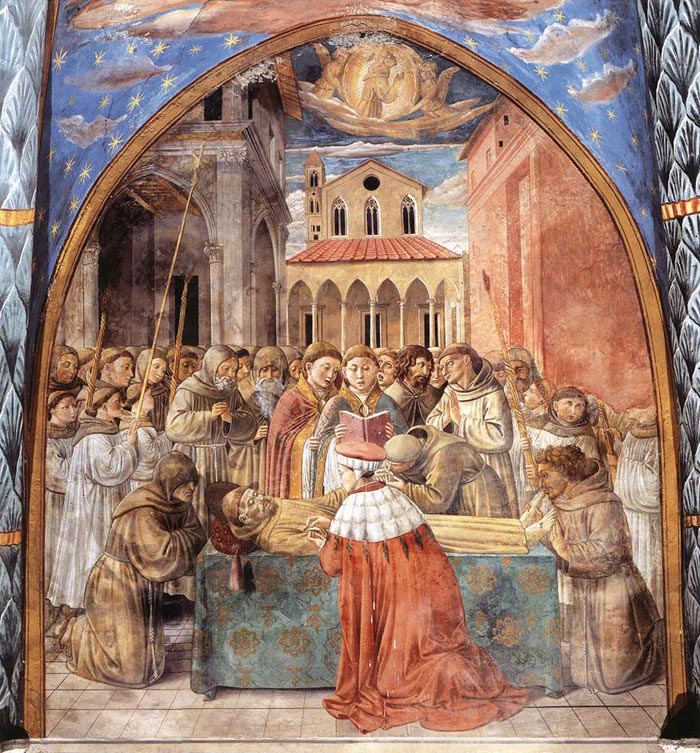 |
Scenes from the Life of St Francis (Scene 12, south wall), 1452, fresco, 304 x 220 cm, Apsidal chapel, San Francesco, Montefalco
|
The last episode in the cycle is the Death and Ascension of Saint Francis. In the foreground, we see the funeral of the Saint who is depicted lying on a bier. His wounds are displayed to the congregation while, behind him, his singing disciples bid him a final farewell. Above the church, in the background, two angels are carrying the soul of St Francis up to heaven in a glory, as confirmed by the inscription: QUANDO BEATUS FRANCISCUS MIGRAVIT EX HAC VITA AD DOMINUM - "How St Francis went from this life to the Lord." |
| |
|
|
Saint Francis and Five Saints from the Franciscan Order in Glory with Angels, vault of the Chapel of the Choir
|
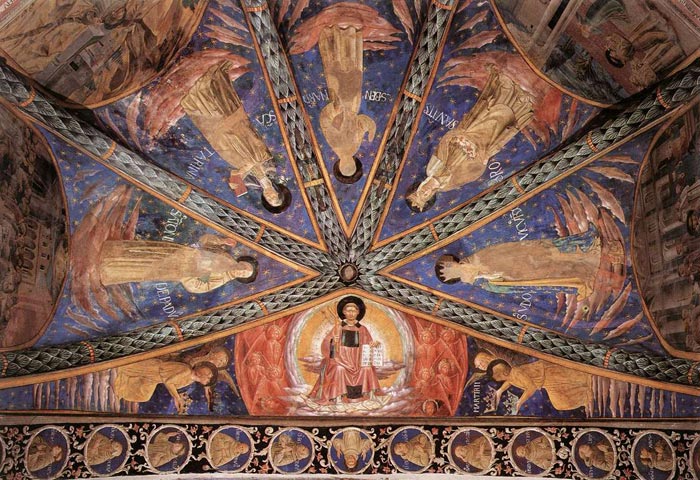 |
Scenes from the Life of St Francis, St Francis in Glory and Saints (vault), 1452, fresco, 304 x 220 cm, Apsidal chapel, San Francesco, Montefalco
|
In the apsidal chapel's umbrella vault, with angels on either side, St Francis is enthroned in glory with angels on either side. In the five spandrels, against a star-studded heaven with cirrus clouds, he is surrounded by the most important saints of the Franciscan order. During previous restoration work the names of the saints were repainted incorrectly: S(ANCTUA) A(N)TO(NIUS), St Anthony of Padua; S(AN)C(T)A CATARINA [sic], St Clare of Assisi; S(ANCTUS)BERNAR(INUS), St Bernadine of Siena; S(ANCTA) ROSA VIT(ERBENSI)S [sic], St Catherine of Siena; S(ANCTUS L)UDOVICU(S) R(E)X, St Louis of France.
The architectural structure of the polygonal apse on a pentagonal plan; covered by a ribbed umbrella vault, obliged Benozzo to make use of an extremely Gothic division of the cycle, which threatened to place limits on his expressiveness. And in fact, while the five Franciscan saints fit in nicely, one to each segment, with their backdrop of a starry sky and support of rose-coloured clouds, the solid St Francis seated in glory is almost squashed into the segment bordering on the underside of the arch, with a sculptural force that spills over into the blazing circle of seraphim, "cut" by the triangular field. The artist's secure grasp of the spatial layout is demonstrated by the foreshortening of the cross in the saint's hand. |
| |
|
|
| During his stay in Montefalco, Benozzo was also commissioned to work on an ancient image of Saint Claire frescoed in the Augustinian convent. Some of the last works he produced during this period were the luminous panel painting of Saint Ursula, two curtain-bearing angels and the donor, now owned by the National Gallery of Art in Washington. |
|
|
